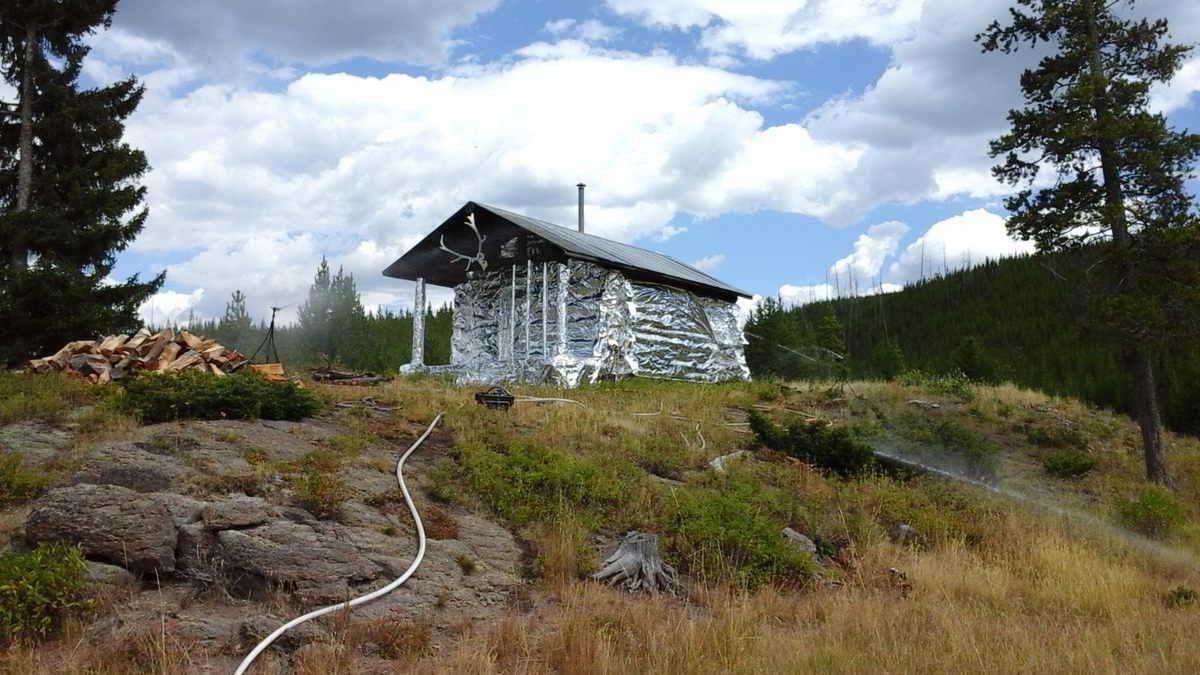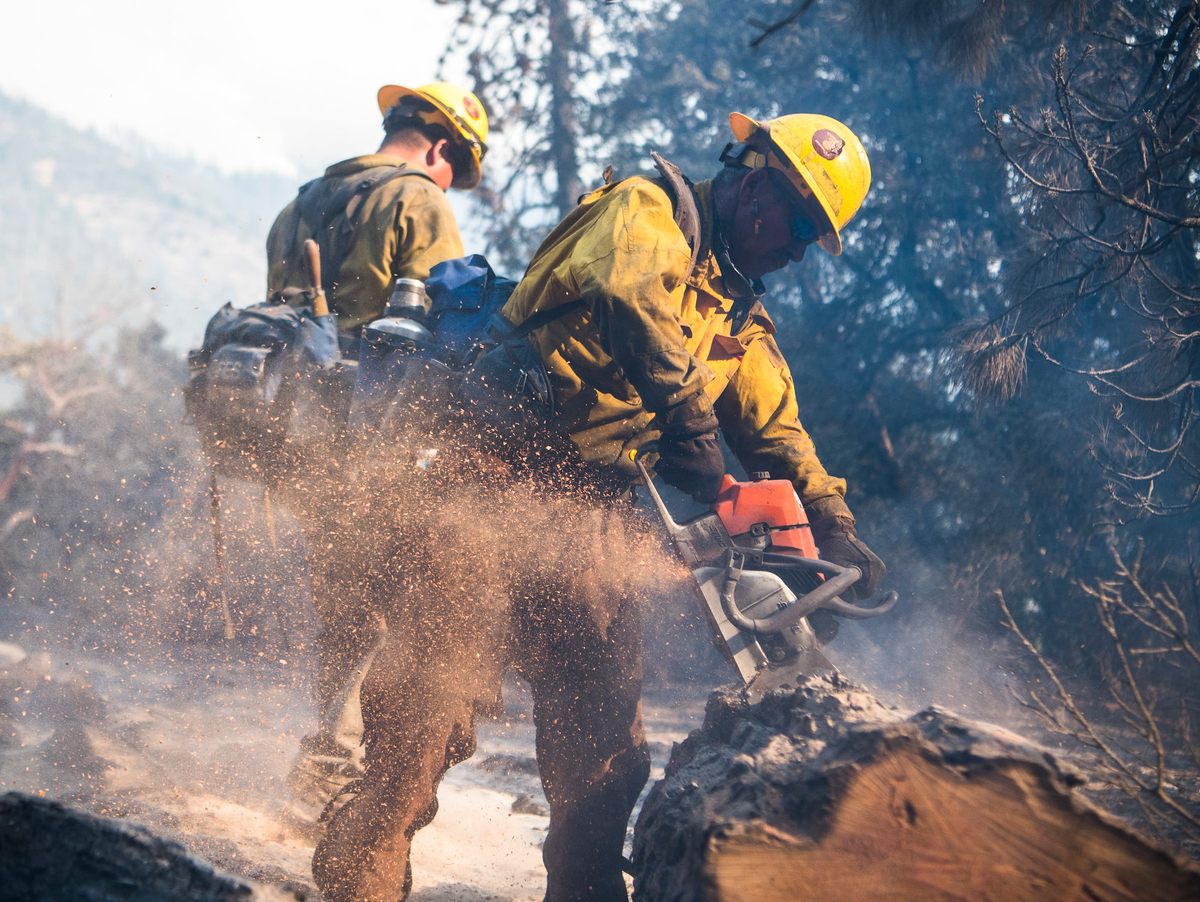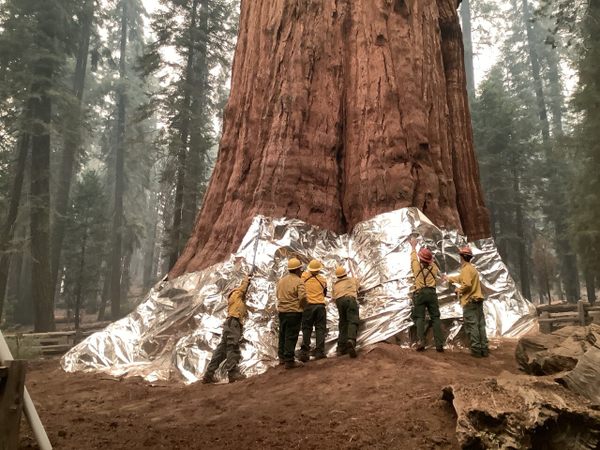In September 2020, as crews outside Yosemite National Park worked to contain the oncoming Creek Fire and evacuate those in its path, archaeologist Jennie Leonard was racing to protect something that couldn’t leave: the giant sequoias in the Mariposa Grove.
Leonard and her fellow resource advisors—who protect species, cultural items, and other resources from wildfire and fire-suppression activities—covered the bases of the ancient trees with structure wrap, a fire-resistant aluminum fabric. Each tree, Leonard recalled, “looked like a baked potato.”
Resource advisors like Leonard have served on wildfires since the 1970s. The National Park Service has deployed them since the start of this century, and their work has become increasingly critical, said Cedar Drake, a Park Service ecologist who coordinates the agency’s resource-advisor training course.
With climate change bringing larger, more frequent, and more destructive fires, resource advisors are needed to guide firefighters in areas where large wildfires have been uncommon, including California’s Redwood National Park and the western reaches of North Cascades National Park in Washington.
“The biggest challenge that I’d say we’re facing is just the scope and scale of fires we’re seeing,” Drake said. “Resource advising is one way that we can adapt to climate change (and) be proactive … having folks on the ground that are providing input to the fire managers and the firefighters so that we can be more sustainable in how we manage these fires in the future.”
Between 2019 and 2022, enrollment in the Park Service’s 35-hour resource-advisor training course increased 125 percent compared to the previous four years; more than 2,600 students from federal, state, tribal, and local agencies have been certified since 2020. The free course went online in 2021 and now routinely reaches its 700-person capacity and sometimes requires a waitlist. Resource advisors, or READs, are based at incident command centers, while advisors called REAFs can work on firelines without an escort.
Many ecologists, biologists, and archaeologists take the READ course. “Nobody’s a resource advisor as your job,” said David Campbell, a biologist and resource advisor at Yosemite National Park and elsewhere. “We’re all just doing this as an extra duty.”
In big parks like Yosemite, local experts can identify critical resources and advise fire crews during both prescribed burns and wildfires. “In an ideal world,” Campbell said, “we are pulling local folks from the local unit as much as possible to represent the resources they know best.”
But in remote or less well-funded areas, resource advisors are sometimes borrowed from other regions, quickly familiarizing themselves with the landscape so they can advise fire crews on protecting plants, animals, and sacred sites.
At Grand Canyon National Park, advisors have access to analog and digital maps showing resources. During fire season, Diné fire archaeologist Jason Nez keeps his communications radio on; when a call comes in, he uses those maps to locate resources in the fire’s path. “Decision-making can happen fast,” said Nez, a member of the Navajo Nation who trains new resource advisors.
Advisors offer suggestions, not commands, but they learn to quickly identify how to protect resources in a variety of circumstances. On one fire, they might help position a fire crew campsite so that firefighters won’t haul gear through invasive weeds and accidentally spread seeds. On another, they might indicate where a bulldozer can safely construct a fireline to prevent erosion into a salmon-rich stream.

In parks that lack the extensive maps and planning abilities of Grand Canyon or Yosemite, the Park Service is developing local unit guides that identify natural and cultural resources, infrastructure, and designated lands and arrange protection measures and communication systems long before fires occur, Drake said. “We need to start being more proactive in terms of knowing where these sites are and having plans ahead of time in terms of how we’ll respond.”
Once resource advisors have the information they need, they’re faced with the challenge of communicating it during an emergency. “Oftentimes, they don’t have experience working with fire crews and firefighting techniques,” said Nez. “That can add a level of stress for inexperienced resource advisors.”
Trainees need to learn how firelines work as well as how to advocate for resources without disrupting operations, so Nez and other instructors take them on smaller local fires to see how crews operate.
Sometimes there’s an us-versus-them mentality between resource advisors and firefighters, but “I’ve never worked with a crew that has intentionally wanted to damage a resource,” Leonard said. “They just don’t know it’s there. Fire folks don’t get the chance to come into our world, and then we launch ourselves into theirs.”
Resource advisors also learn to work with tribes and tribal communities. Dirk Charley, a retired tribal relations program manager for the U.S. Forest Service in California and a member of the Dunlap Band of Mono Indians, said that communication among tribes, resource advisors, and federal and state agencies helped protect a sacred area during the 2021 KNP Complex Fire in Sequoia and Kings Canyon.
For tribes, identifying such areas may require “sharing a tribal map that’s very near and dear to them,” said Charley, a former wildland firefighter who now trains resource advisors and occasionally serves as a tribal liaison for the Forest Service during California fires. Recently, he showed a class of fire archaeologists how to protect pictographs from smoke and heat damage in the Sierra National Forest by creating defensible spaces before wildfires start.
Communication is important long after the smoke clears. “Everybody goes home after the fire,” Charley said. “But the forest, or the park, has a mess. And the tribes, they have a mess.”

Resource advisors are often asked to help with post-fire cleanup. In 2022, Leonard worked with a crew in California that was removing hazardous standing trees. Where cultural artifacts had been exposed by the fire, they used downed trees to create barriers along the road, making the area less accessible to curious visitors.
Drake and his team are also developing a template that agencies and communities outside the parks can use to protect resources and thereby avoid “scrambling to try to gather that information while the fire’s burning,” he said.
The resource-advisor model isn’t limited to fires; the Forest Service also uses resource advisors before, during, and after catastrophic events like floods and hurricanes, which could become more frequent in a changing climate.
It also employs them for special events, including unauthorized ones like the annual Rainbow Gathering, said Hilary Markin, a public information officer for the agency’s National Incident Management Team. Large groups can cause soil compaction, water quality, and sanitation problems, and disturb sensitive species and archaeological sites, she said—and they may be more resistant to suggestions than a fire crew.
In Yosemite, two years after resource advisors wrapped sequoias at the Creek Fire, the Mariposa Grove was threatened by the fast-moving Washburn Fire. Campbell, who was the lead advisor, worked with a team of sawyers to remove dead and downed wood around the sequoias and pull out flammable duff.
Once again, the sequoias survived, but in recent years, more than 14,000 giant sequoias in similar groves have been lost to wildfires—close to 20 percent of the entire species. “We’re on a trajectory to lose giant sequoias for all of time,” said Campbell. Tree by tree, resource advisors work to stem that loss, now and for years to come.
This story is part of High Country News’ Conservation Beyond Boundaries project, which is supported by the BAND Foundation.
